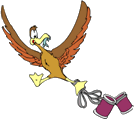Marine Conservation
No Matter Where You Live You Have An Impact On The Health of Our Ocean!
One of the most important things you can learn today is that your actions make a difference to the health of the Ocean. That's right. You don't even have to live near the ocean to make an impact. And even if you do, you might be surprised. Scientists have studied the oceans and believe that a single drop of water can travel around the world via ocean currents in as little as 200 days! Only 200 days! That's amazing!
But what if that drop was not water? What if it was pollution such as oil or gas or even pesticides from our gardens? Or trash? In fact the, the most deadly thing affecting our marine animals today is pollution. From paper products to plastics, chemicals to petroleum products, marine pollution is not just ugly, but causes many health problems for the animals that live in our oceans. Can you help prevent these things from getting to the
 Though plastic products have helped us in many ways by reducing the number of trees used, they have created another problem we didn't foresee. Paper products, being naturally produced, break down when exposed to the elements. Plastic products, being as strong and durable as they are, can take at least 800 times longer to break down in the Ocean. For example a paper milk carton takes 6 months to disintegrate in the sea whereas a plastic bottle will take more than 400 YEARS! That means that for every plastic bottle dumped in the ocean, we will have to wait over 7 human lifetimes for that one bottle to decompose.
Though plastic products have helped us in many ways by reducing the number of trees used, they have created another problem we didn't foresee. Paper products, being naturally produced, break down when exposed to the elements. Plastic products, being as strong and durable as they are, can take at least 800 times longer to break down in the Ocean. For example a paper milk carton takes 6 months to disintegrate in the sea whereas a plastic bottle will take more than 400 YEARS! That means that for every plastic bottle dumped in the ocean, we will have to wait over 7 human lifetimes for that one bottle to decompose.
But to add to our concerns, plastic six-pack rings for beverages, balloons, plastic straws and styro-foam are deadly to marine mammals and other marine animals. Plastic six-pack rings are almost invisible underwater, so animals cannot avoid them. They often get caught around their necks and strangle or suffocate.
Floating balloons look like jellyfish or other tasty food, but the rubbers and attached string can block the intestines of marine mammals. Styrofoam takes 50 years to break down in the sea and can cause intestinal blockage if swallowed by marine mammals. Plastic pellets resemble fish eggs and sea birds will eat them.
 Discarded fishing line is a particularly hazardous item for marine life. Difficult to see and even harder to get free of, fishing line can entangle animals, causing injury or death. For dolphins, fishing line can wrap around a flipper or tail fluke and, over time, cut through the fin. Fatman, an adult male at Dolphin Encounters, is easily recognized by the missing portion of his dorsal fin -- a suspected injury from entanglement many years ago in the wild.
Discarded fishing line is a particularly hazardous item for marine life. Difficult to see and even harder to get free of, fishing line can entangle animals, causing injury or death. For dolphins, fishing line can wrap around a flipper or tail fluke and, over time, cut through the fin. Fatman, an adult male at Dolphin Encounters, is easily recognized by the missing portion of his dorsal fin -- a suspected injury from entanglement many years ago in the wild.
Just like it is for us, swimming in chemicals, gas or oil can make marine animals very sick and can even be fatal. Fuel spills from boats are just as harmful as run-off of chemicals from the land - such as fertilizers, gas and oil, anti-freeze or bleach. Just like us, dolphins are particularly at health risk from chemical pollution just like we are. Toxins accumulate in the food chain when small animals eat contaminated plants and, in turn, larger animals eat those animals
According to Dr. Ken Norris, "...When a dolphin swallows a toxic pollutant (fish), its body steers the dangerous molecules into its fat layer - the coat of blubber that protects the animal from the cold. Here it accumulates... until the dolphin calls on this food storage. As the toxins flood back into the body of the dolphin, normal physiological processes can be disrupted and the animal can die quickly."
But what can you do to make a difference? First, you have to find out what the problems are… and you've done that by reading this page. Second, turn the page to find out the simplest things that you can do to help keep our Ocean healthy!
Do The Ten: No Matter Where You Live, You Promote A Healthy Ocean By Doing The Top Ten:

